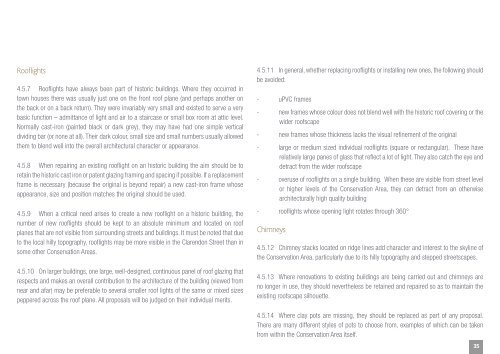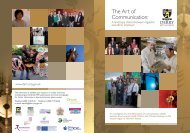CLARENDON STREET - Derry City Council
CLARENDON STREET - Derry City Council
CLARENDON STREET - Derry City Council
- No tags were found...
Create successful ePaper yourself
Turn your PDF publications into a flip-book with our unique Google optimized e-Paper software.
Rooflights4.5.7 Rooflights have always been part of historic buildings. Where they occurred intown houses there was usually just one on the front roof plane (and perhaps another onthe back or on a back return). They were invariably very small and existed to serve a verybasic function – admittance of light and air to a staircase or small box room at attic level.Normally cast-iron (painted black or dark grey), they may have had one simple verticaldividing bar (or none at all). Their dark colour, small size and small numbers usually allowedthem to blend well into the overall architectural character or appearance.4.5.8 When repairing an existing rooflight on an historic building the aim should be toretain the historic cast iron or patent glazing framing and spacing if possible. If a replacementframe is necessary (because the original is beyond repair) a new cast-iron frame whoseappearance, size and position matches the original should be used.4.5.9 When a critical need arises to create a new rooflight on a historic building, thenumber of new rooflights should be kept to an absolute minimum and located on roofplanes that are not visible from surrounding streets and buildings. It must be noted that dueto the local hilly topography, rooflights may be more visible in the Clarendon Street than insome other Conservation Areas.4.5.10 On larger buildings, one large, well-designed, continuous panel of roof glazing thatrespects and makes an overall contribution to the architecture of the building (viewed fromnear and afar) may be preferable to several smaller roof lights of the same or mixed sizespeppered across the roof plane. All proposals will be judged on their individual merits.4.5.11 In general, whether replacing rooflights or installing new ones, the following shouldbe avoided:- uPVC frames- new frames whose colour does not blend well with the historic roof covering or thewider roofscape- new frames whose thickness lacks the visual refinement of the original- large or medium sized individual rooflights (square or rectangular). These haverelatively large panes of glass that reflect a lot of light. They also catch the eye anddetract from the wider roofscape- overuse of rooflights on a single building. When these are visible from street levelor higher levels of the Conservation Area, they can detract from an otherwisearchitecturally high quality building- rooflights whose opening light rotates through 360°Chimneys4.5.12 Chimney stacks located on ridge lines add character and interest to the skyline ofthe Conservation Area, particularly due to its hilly topography and stepped streetscapes.4.5.13 Where renovations to existing buildings are being carried out and chimneys areno longer in use, they should nevertheless be retained and repaired so as to maintain theexisting roofscape silhouette.4.5.14 Where clay pots are missing, they should be replaced as part of any proposal.There are many different styles of pots to choose from, examples of which can be takenfrom within the Conservation Area itself.35
















